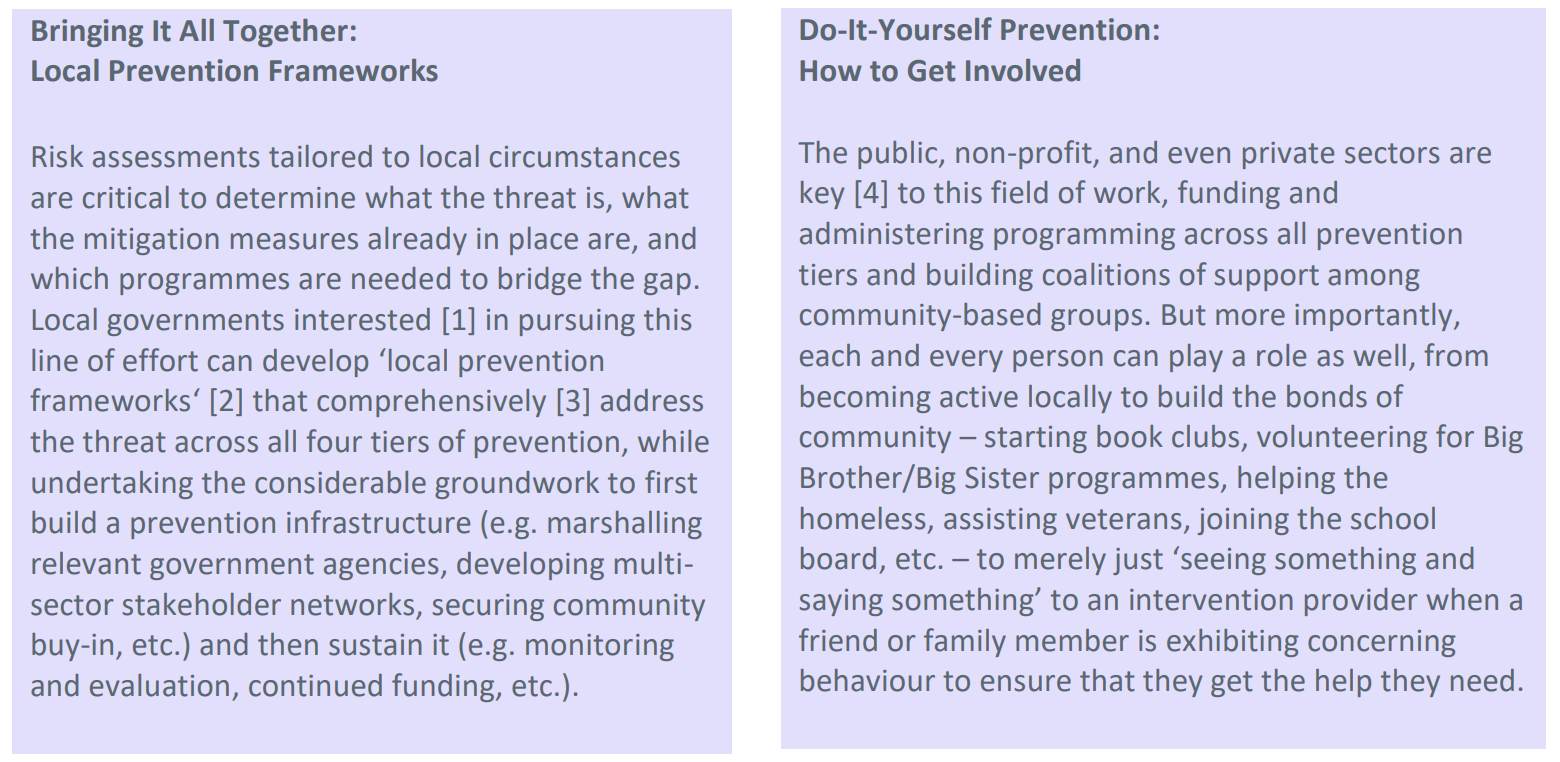The ‘Public Health Approach’ to Prevention
By: Jordan Reimer
A downloadable version of this page can be accessed here.
Introduction
The ‘public health’ model is a comprehensive approach to preventing targeted violence. Rooted in a scientific field focused on general health, safety, and well-being, the model is based on one utilised by the U.S. Centers for Disease Control (CDC) to prevent violence more generally. The model envisions building thriving communities and individuals resilient to violence – and by extension, violent extremism. To do so, it focuses on minimising any negative conditions that could lead to targeted violence taking root on both a societal and individual level (‘risk factors’), while boosting those conditions that help inoculate communities and individuals from susceptibility to targeted violence (‘protective factors’).
Rather than isolating any specific communities as ‘vulnerable’ to violent extremism, or focusing on any particular strains of violent ideology, the public health model instead focuses on indicative behaviours, recognising that targeted violence can manifest in any susceptible individual and is often enabled by their environment – whether familial or communal, physical or online. Accordingly, the public health approach tackles risk factors at both the individual level (e.g. social isolation) and community level (e.g. degree of criminality), while also promoting protective factors at those two levels (e.g. social connectedness, economic stability). It recognises that violent extremist recruiters often exploit broader social challenges such as the lack of a sense of purpose or belonging or feelings of political powerlessness. Public health approaches to prevention therefore seek to ameliorate these broader issues in a way that can strengthen individuals and communities holistically, including and beyond building resilience against targeted violence.
Importantly, each individual and community’s respective risk and protective factors are unique to them. Accordingly, the public health model requires that stakeholders interested in tackling targeted violence have a clear understanding of the who, what, when, where, why, and how of targeted violence in their areas of responsibility. Once stakeholders understand both the vulnerabilities as well as the available remedies in their population, they can then figure out how best to address the former, bolster the latter, and deal with any gaps in between. These solutions require the involvement of all elements of society – educators, families, religious leaders, mental health counsellors, law enforcement, academia, and more – to pursue a variety of programmatic efforts: employment and economic opportunity, housing, social engagement, counselling, mentorship, trauma-informed care, etc. This is not to ignore the role that ideologies can play, but to respond primarily to the broader susceptibilities within which a violent ideology secures its relevance.
Such efforts are concentrated in four different ‘tiers’ of prevention: primordial, primary, secondary, and tertiary. (Some models only include three tiers, combining primordial and primary prevention.) In the public health model, it is important that any such program is ‘evidence-based’ – that is to say, each prevention program require an independent, rigorously-conducted evaluation that can help determine its effectiveness. Consequently, only programmes that have been shown to be effective continue to be implemented, while allowing for new, innovative programmes to be trialled and evaluated.
This Explainer outlines the tiers of prevention individually along with the types of programming associated with each. It includes the steps that we – collectively and individually – can take to prevent targeted violence. It then addresses the arguments made against this model and concludes with a discussion of its advantages over previous approaches.
Primordial Prevention: Reduce
The goal of primordial prevention is to foster healthy, resilient communities and individuals by tackling the variety of social ills that could negatively affect them. (For communities that can include racism, hate crimes, and polarisation; for individuals, the loneliness epidemic, deaths of despair, and domestic abuse.) The ultimate goal is to foster an environment that is naturally resilient to any of the risk factors associated with targeted violence from developing in the first place. According to the public health model, if this can be accomplished, one natural consequence is the reduction of all violence, including targeted violence.
In line with this thinking, the following programming common to targeted violence prevention falls under primordial prevention:
- Civic engagement: fostering initiatives that encourage community engagement and shared achievements, education, and resilience, which can lead to improved social cohesion, reduced inter-group tensions, and reduced youth vulnerability.
- Youth resilience programmes: those that increase social capital, a sense of belonging, and the feeling of security – e.g. leadership training, mentorship, employment skill building, civic engagement, etc.
- Law enforcement community engagement: strengthening the ties between police and community to build mutual trust.
Primary Prevention: Inoculate
With primary prevention, the goal is to prevent targeted violence more directly through concerted efforts to build community and individual resilience to it. This includes, for example, population-wide efforts to raise awareness about targeted violence, including on how to recognise and respond when it manifests. In this manner, primary prevention leverages the whole of society to foster an environment where intervention and support are proactively sought by those who have concerns. But it is also about building the knowledge base of the targeted violence threat, including extremist narratives and modes of communication, so that individuals are more immune to such recruitment or to falling into extremist ‘rabbit holes‘ online.
Accordingly, the following approaches to targeted violence prevention fall under primary prevention:
- Training and awareness-raising: providing education across all of society – community leaders, educators, tech companies, medical professionals, law enforcement, service providers, etc. – about mobilisation to violence and the risk and protective factors related to mobilisation to violence.
- Bystander training: enhancing the ability of individuals to recognise signs of mobilisation to violence, take steps to engage with individuals, and provide them with assistance and/or refer them to other resources.
- Countering extremist influence online through media literacy and/or online critical thinking education (sometimes referred to as ‘digital citizenship‘).
Secondary Prevention: Disrupt
Building off primary prevention, secondary prevention seeks to develop the infrastructure that can provide interventions for vulnerable individuals as needed. Secondary prevention requires the capacity to assess whether individuals exhibiting concerning behaviour pose a credible threat and then determining what assistance, if any, would be necessary to assist that individual and help guide them away from a path of violence – whether through mentoring, counselling, religious guidance, psycho-social support, mental health treatment, etc. Often the goal is not ‘deradicalisation’ itself – ensuring the individual harbours no radical beliefs – but rather ‘demobilisation’ or ‘disengagement’: ensuring the individual does not seek to engage in violent activity in line with those beliefs.
The following approaches fall under secondary prevention:
- Referral services: establishing a phone/text/app/web-based hotline to enable concerned individuals to refer their concerns to expert practitioners or receive guidance on next steps.
- Threat Assessment and Management Teams (TAMTs), otherwise known as Behavioural Intervention Teams: developing multi-disciplinary teams that can both assess a threat and devise interventions for each individual’s unique situation.
- Intervention services: providing ‘wrap-around’ services through various service providers to administer tailored support to individuals so they avoid becoming involved in targeted violence.
Tertiary Prevention: Mitigate
Tertiary prevention is similar to secondary, except it focuses on those who have already mobilised to violence or are otherwise involved in the justice system. To that end, tertiary prevention seeks to provide intervention services for these individuals, assisting their rehabilitation and/or reintegration into society following release from prison by minimising risk factors and increasing protective factors that could prevent recidivism.
An important, but sometimes overlooked, corollary to tertiary prevention is caring for a community following an incident of targeted violence. Helping communities heal following a violent attack, such as by centering victims’ stories or providing trauma-informed care to survivors and first responders, can restore an affected community’s sense of resilience and ultimately prevent retaliatory violence that could only exacerbate social fractures.
As such, the following efforts are considered tertiary prevention:
- Intervention services: providing ‘wrap-around’ rehabilitation services through various service providers to administer tailored treatment to incarcerated individuals as well as reintegration services to those being released.
- Local governmental and community leadership following an attack, providing appropriate public communications, robust community engagement, psychological treatment, and other supports to foster communal unity.
Conclusion
The tenets of the public health model have been embraced by countries across the globe (even if those governments don’t use that exact language), as they increasingly face extremist violence across the ideological spectrum. Of course, that isn’t to say that the approach does not have its weaknesses: primordial prevention is so expansive that labelling related programs as ‘targeted violence prevention’ might be reductive and unnecessarily stigmatising to beneficiaries; primordial and primary prevention are so upstream from violence that it is very hard to prove a negative (‘This program prevented X instances of targeted violence’) and thereby demonstrate outcome effectiveness; secondary prevention involves subjecting individuals to scrutiny and labelling them as a potential ‘threat’ despite the fact that they have not engaged in violence or criminal activity; etc. – not to mention just how resource-intensive a fully-realised version of this model would be, across all tiers.
But as the field of preventing targeted violence matures, practitioners have welcomed the public health approach because it, unlike previous iterations of ‘countering violent extremism’ programmes that targeted specific communities or were predominantly driven by law enforcement, is agnostic to any particular form of violent extremist ideology and seeks to ‘de-securitise’ the field by incorporating all segments of society to address the issue. At the same time, the approach recognises that there is value in tailoring programmes to specific contexts, understanding that there are context-specific risk and protective factors for both communities and individuals that must be considered at all tiers of prevention.
It is this recognition that hyper-local environmental factors can drive extremism (and that extremism therefore isn’t inherent to any one community), that helps ensure that efforts to address it do not fuel prejudices, stigmatise any community, or alienate any groups – marginalised or otherwise. In this manner, the public health approach can help uphold human rights principles in the prevention of targeted violence.
Further reading
Kamaldeep Bhui, Madelyn Hicks, Myrna Lashley, and Edgar Jones, “A public health approach to understanding and preventing violent radicalization,” BMC Medicine Vol. 10:16 (2012), https://bmcmedicine.biomedcentral.com/articles/10.1186/1741-7015-10-16.
Stevan Weine, David Eisenman, Janni Kinsler, Deborah Glik, and Chloe Polutnik, “Addressing violent extremism as public health policy and practice,” Behavioral Sciences of Terrorism and Political Aggression, Volume 9:3 (2017), https://cphd.ph.ucla.edu/sites/default/files/downloads/cve%20article%202_0.pdf.
Jonathan Challgren, Ted Kenyon, Lauren Kervick, Sally Scudder, Micah Walters, and Kate Whitehead, Countering Violent Extremism: Applying the Public Health Model, Washington: Georgetown University Center for Security Studies (2016), https://georgetownsecuritystudiesreview.org/wp-content/uploads/2016/10/NSCITF-Report-on-Countering-Violent-Extremism.pdf.
Justin Snair, Anna Nicholson, and Claire Giammaria, Countering Violent Extremism Through Public Health Practice: Proceedings of a Workshop, Washington: National Academies Press (2017), https://nap.nationalacademies.org/catalog/24638/countering-violent-extremism-through-public-health-practice-proceedings-of-a.
Neil Krishan Aggarwal, “Questioning the current public health approach to countering violent extremism,” Global Public Health, Vol. 14:2 (2019), https://pubmed.ncbi.nlm.nih.gov/29749294.
_________________________________________________________________________________
This Explainer was uploaded on 16 August 2023.





